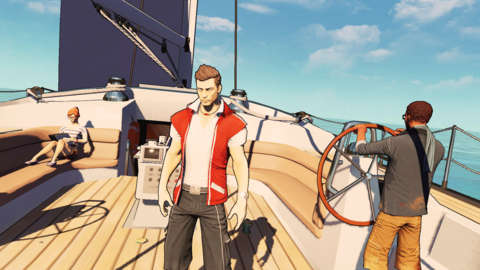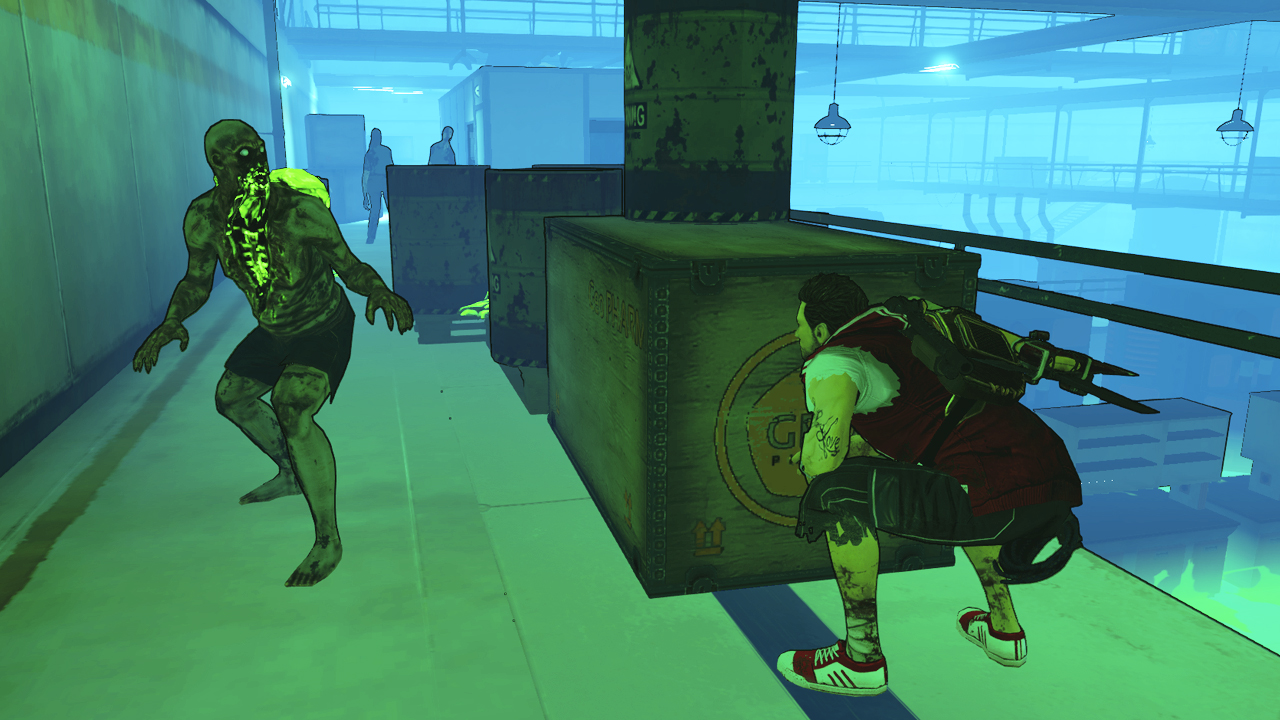There's a pervasive plainness to Escape Dead Island that hasn’t been common since the PlayStation 2 days. This zombie joins the list of competent yet unremarkable third-person survival adventures like Extermination and Cold Fear, games with Resident Evil-branded chips on their shoulders. You might be initially curious to know what answers Escape Dead Island, as an expository side story to the original Dead Island, could offer that would shed light on the series' initial outbreak. But Dead Island's mysteries are likely not what compels you to keep up with the franchise.
To reinforce the perception of Escape Dead Island’s story as a canonical spin-off, this action adventure game is viewed from the third person rather than the first person perspective used in the prior installments. Moreover, the art direction foregoes the detail and grit of the prior games in favor of a graphic-novel-in-action look, right down to the 1960s Batman-inspired onomatopoeias during combat. The motion-comic style of the cutscenes between chapters are one of the game's few strengths, which made me wonder if this tale would have been presented better as a full graphic novel, digital or otherwise.
This art style certainly doesn't do survivor and zombie slayer Cliff Calo any favors. His unkempt beard, permanently furrowed brow, and Ian Somerhalder eyes make him the leading contender for the cockiest-looking protagonist of 2014. After a few hours, he reveals himself to be a more likable hero, who spits off chuckle-inducing one-liners that would make Arnold Schwarzenegger blush. The “best” include, "How you like them brains?", "Mind under matter," "Get some sleep. You look dead tired," and "Let me axe you a question."
Propelled by the need to impress his dad, Cliff and his two journalist friends have taken to the seas--thanks to the boat Cliff stole from his dad--to investigate the rumors surrounding Banoi, the locale of the first Dead Island. Instead, they end up at Napapela, which is in the same archipelago, and is conveniently affected by the same outbreak as Banoi. Cliff's motivations do more than hint at daddy issues, which reach hamfisted levels with physical manifestations of emotional baggage by the second half of the story. Coupled with a series of dream sequences inspired by Groundhog Day, you're left wondering what is a hallucination and what is reality. When some of the chapters begin with him waking up from the same bed inside a shipping container, you wonder if any of this is real at all. These tricks of perception are further explored in the new-game-plus playthrough, where subtle changes to map progression and narrative pique your curiosity. It’s enough to draw you in for another few hours, but not enough to warrant a second full playthrough.

Escape Dead Island's uninspired design extends to its inventory system. It's neither as deep as the expandable suitcases of Resident Evil 4 nor as sparse as I Am Alive. There's no submenu for items; weapons like the pistol or katana are simply accessible with a single button press. Gear-like ropes and grapple hooks function more like keys than inventory items, since they're only useful in very specific areas. Even the gas mask auto-equips if you step foot in a toxic area. And it wouldn't be a zombie game without a makeshift melee weapon. Cliff's best creation is a multi-bladed hatchet on a pole, which he makes without your help. The lack of crafting further underscores the shallowness of Escape Dead Island.
One of the genre's conundrums is not knowing how many items should be saved in anticipation of a major fight. If you play conservatively, you end up vanquishing the final boss in less than 10 seconds due to having more rocket launcher rounds and other explosives than they know what to do with. Escape Dead Island saves you the time and effort of pondering item conservation because it doesn't have items for you to hoard aside from ammo. Furthermore, you only have two guns, a pistol and a shotgun.
Gear-like ropes and grapple hooks function more like keys than inventory items, since they're only useful in very specific areas.
Overall, the mix of optional zombie encounters versus mandatory ones is an even split. The sensation of pulling off a quiet, effective, and gruesome kill captures the same satisfaction as a discrete takedown in other stealth-intensive games like The Last of Us and the Splinter Cell series. Even if you prefer confronting over fleeing from zombies, be prepared for the latter. It's not because some sections are particularly hard or overwhelming; there's just no practical incentive to thoroughly cleanse Napapela of the undead. These zombies drop no loot to redeem or spend in stores because no such economies exist, and you can't earn experience since there's no ability-based progression to worry about. It doesn't make Escape Dead Island wholly boring, just one-dimensional.
Escape Dead Island also suffers from poorly-placed checkpoints, the kind that force you to endure a real-time cutscene or conversation before you're allowed to jump back into the action. Even worse, any death and subsequent respawn might result in the game freezing. This occurred an average of once per chapter (out of 11 chapters) during my PlayStation 3 playthrough, while I encountered slightly fewer lock-ups on a PC.


Napapela is as deep as it is wide, and while the square shape of the map implies a wealth of exploratory possibilities, this island is the furthest thing from an open world. With rooms filled with toxic fumes and locked doors that only upgraded weapons can unlock, traveling through the island is a deceptively linear experience. You have little choice but to move toward your current waypoint and there is little to no motivation to deviate from your course. Aside from a lengthy chapter in which you're tasked with retrieving three access cards from the other side of the island, all other key cards are close to the locked door you're looking to open. There's no guesswork; even the zombies who have the key cards you're looking for are clearly highlighted. I was pleased that the waypoint indicators are easy to follow and continually update as you reach each respective point. In a game in which every hurried footstep counts in avoiding zombies, the optional convenience of these indicators (you need to hold down a button to see your waypoint) did not diminish my experience. Escape Dead Island's few saving graces are the shortcuts that become available later in the game. Much like opening a one-way door in Dark Souls, using newly acquired grappling hooks and other gear turns a 15-minute trek into a five minute stroll. You can tell this was inspired by the best Metroid and Castlevania games, but the application of these influences feels lazy and trite.
The only reason you might want to go off the beaten path would be to hunt for collectables, and even those items offer scant insight on the cause of the infection. In the interest of a thorough investigation, Cliff's colleague in crime, Linda, asks him to take photos of newsworthy locales and objects, but since obtaining a complete collection of photos doesn't yield anything worthwhile, this side mission carries little value.
As an origin tale, Escape Dead Island is hampered by an issue common to the zombie genre: the appeal of the narrative focusing on the characters' day-to-day survival, combined with little attention being given to finding a remedy to stop the outbreak. When I finished Dead Island three years ago, I wasn't compelled to scour forums to theorize the root causes of the infection. There was enough exposition by game's end and whatever mysteries were left unsolved left me feeling indifferent. Despite my profound apathy regarding making sense of Cliff's hallucinations and dreams, there was at least some satisfaction in silently assassinating the undead.